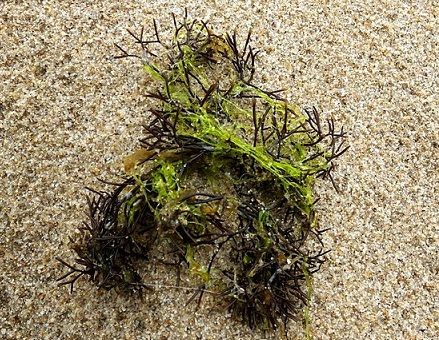A type of seaweed known as black carrageen or crab’s bed could provide a valuable source of food for piglets and cows. As well as being near at hand (it grows in large quantities in the waters round Bornholm) it is good for the animals’ digestion and generates less methane in their stomachs, reports DR Nyheder.
Anthropologist Ole Hertz from Gudhjem has been working in seaweed production for a numbers of years – partly as part of the Nordic Seaweed Project. “If we can replace soya from Brazil with seaweed, we will be able to use less penicillin and zinc in pigsties, and less methane will have a beneficial effect when it comes to greenhouse gases,” said Hertz.
A win-win situation
As well as not having to transport the beans half way around the world, harvesting the seaweed will also have the effect of removing some of the phosphorous and nitrogen from the Baltic. Hertz is setting up a small-scale trial to use seaweed as protein in conjunction with a local trawler company, the local fisheries association and the deputy head of the Landbrug og Fødevarer agricultural organisation.
At the same time, researchers from Aarhus University are conducting experiments to see whether seaweed can be used as a dietary additive for piglets while the Technical University of Denmark (DTU) is investigating just how much seaweed can be harvested without harming the environment.
New skin disease centre planned
Backed by 400 million kroner over four years from the Leo Fund, the University of Copenhagen intends to set up a new research centre to look into and treat skin diseases that affect an estimated 25 percent of the world’s population. The centre aims to gather together Danish and international researchers in immunology and skin disease in the hope of gaining new knowledge that in the long term could lead to better diagnoses and more effective treatments of conditions such as psoriasis and eczema. The centre will be located on the 12th floor of the University’s Mærsk Tower.
Weeding out the great unwashed
As any visitor to a Danish swimming pool knows, you should take a shower before getting into the water. Before you decide to sidestep this, bear it in mind that in extreme cases it may be necessary to close the pool due to unacceptable levels of bacteria in the water. Slagelse Municipality has decided to install an ultraviolet light in the corridor leading from the showers to the pool in order to shed light on culprits. “UV light can reveal bacteria, so it makes sense to install this in a swimming pools like ours where a lot of people share the same water,” said Ronni Børgesen, the team leader at the Korsør swimming baths. “Now we can draw our bathers’ attention to good hygiene in a fun and alternative way without it being necessary to add more chlorine to the water,” he added.
Old bones – new secrets
Research carried out on 10,000-year-old bones and skulls discovered in Brazil in 1840 has thrown up an intriguing new conundrum. Danish evolutionary biologist Eske Willerslev has obtained DNA samples from the inside of the skulls and 1-2 percent of it stems from Australasian people who lived on Pacific islands near to Australia and New Guinea, reports Videnskab.dk. The mystery is how did the DNA get there? “The find is confusing, and raises all sorts of questions regarding how and when the first people came to America,” said Victor Moreno Mayar, one of the researchers. Maybe a latter-day Thor Heyerdahl is needed to mount a new Kon-Tiki expedition to help solve the mystery.
Who is Ludvig Lorenz?
A newly-published book written by Helge Stjernholm Kragh is attempting to reclaim the Danish scientist Ludvig Lorenz from the virtual obscurity into which he has sunk. Lorenz was active in the mid-19th century as a pioneer in the study of optics and understanding the properties of light in mathematical terms. He was the first to derive a specific law relating a body’s refraction index to its density – a law still used in modern physics along with his complex theory of light scattering on spherical molecules, which was completed just before his death in 1891. The book, ‘Ludvig Lorenz – A Nineteenth-Century Theoretical Physicist’, is available from the Royal Danish Academy.
















